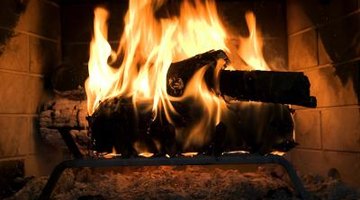How to Make a Block Off Plate for a Wood Stove
Whenever you are retrofitting a chimney to use with a wood stove, a block-off plate is necessary for sealing the fireplace opening. Also known as a damper seal, a block-off plate keeps soot from entering the hearth and protects from cold drafts. It effectively seals off a home from the chimney. Many fireplace inserts come with seals for this purpose, but if you're doing the job yourself, you will need to shape sheet metal to fit in the opening.

Step 1
Remove the fireplace damper and set the stove in its intended place so you can determine where the stove piping will pass through.
Step 2
Take measurements to determine the lengths and width of the plate you will cut out of the sheet metal. The first measurement you will make is the front length. Measure the front length across the opening, at 2 inches above the fireplace opening. At the same height, measure the back of the opening. Then, measure the width of the opening from the front to the back.
Step 3
Measure and cut 24- or 26-gauge sheet metal, adding an extra inch to each measurement. This extra measurement will serve as a 1-inch flange or lip around all four edges of the plate.
Step 4
Bend the flanges to a 90-degree angle and notch the corners, using a soft hammer and bending the metal over the edge of a table.
Step 5
Set the plate in the chimney flue to see if it fits. Bend or shape the flanges as needed to fit securely.
Step 6
Position the stove pipe in its place in the chimney and mark where it will penetrate the plate. An easy way to do this is to measure the distance of the pipe from the back and side of the flue. Then, use a spare piece of pipe and place it on the sheet metal according to the placement you've measured. Trace and cut out the hole in the sheet metal with a hole-cutting drill attachment.
Step 7
Insert the plate up in the opening so the stove pipe goes through the hole. Secure by hammering masonry nails through the plate flanges and into the mortar. This is not necessary, as the plate will likely stay put without this extra security. Apply stove cement between the pipe and the hole to seal the joint.
Tips
- An alternative, but less secure method for sealing the damper is to cut through the damper without removing it. Use a reciprocating saw to cut a hole slightly larger than the stove pipe and fit the stove pipe through.
Writer Bio
Carly Fiske has been writing professionally since 2009. She writes for websites including greenanswers.com, openoffer.com and thirdage.com. Fiske holds a Bachelor of Arts in cultural anthropology from the University of Redlands.
Photo Credits
- Thinkstock Images/Comstock/Getty Images
More Articles



